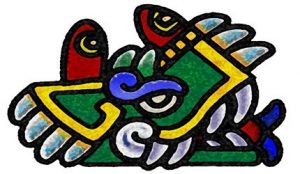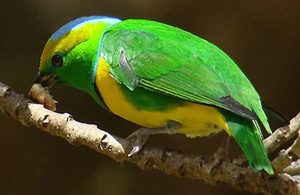With the impact of the 9.0 Japanese earthquake still reverberating around the world, renewed interests in the myths and legends about earthquakes and volcanoes have sprung up around the world. In Costa Rica, a land familiar with both fire mountains and earth shakers, the tales told by ancient tribes who lived in the shadow of giants such as Arenal and Turrialba have passed down to their descendents and are now told as part of modern Tico culture.
Earthquake Legends of the Nahua
The Nahua (guatusos) of Guanacaste believed that Tepeyollotl (heart of the mountains), of their Aztec ancestors, ruled over earthquakes. Pictured in drawings and petroglyphs as a fierce jaguar leaping towards the sun, Tepeyollotl was the perfect representation of the power and unpredictability of an earthquake. It’s not hard to imagine such a primal force emanating from the very heart of the mountains, springing forth like the mythical jungle cat to topple the unwary prey.

The Nahua creation myth of the world of the fifth sun, in which legend tells us is the one we now inhabit, has a curious relationship to the Japanese legend concerning earthquakes. It is said that Japan rests on the back of a giant catfish named Namazu and when the catfish turns, earthquakes occur. The Nahua creation story tells that North and Central America were formed from the back of a giant caiman, Cipactli, that was caught by the gods and trapped because all the land was on its back. To the ancients, the twisting of Cipactli would explain the shaking of the land as the caiman tried to escape its fate.
Earthquake Legends of the Chorotegas
The Chorotegas brought their Mayan ancestor’s myths to Nicoya when they left their Mexican homes to discover paradise. The earthquake legend was simple and frightening: the world was actually shaped like a square and held at each of the four corners by the Vashakmen (gods) who maintained watch over the number of people. When the world became overcrowded, the four Vashakmen would merely tip the square and the excess people would fall off. That tipping is what we call earthquakes. Fortunately, here in Costa Rica, we have always believed in balance of nature and humankind, so the Vashakmen’s work is limited.
Legend of Poás Volcano
Volcanoes in Costa Rica have their own myths, which are as unique and diverse as these fire mountains themselves. One of the most beautiful is the legend of how Poás volcano came to be. This sentinel of the Alajuela area is renowned for its two crater lakes and stunning views. Long before the Spanish arrived, the forest surrounding Poás was home to countless birds, including the Rualdo whose golden song richly compensated for its rather plain plumage.
This Rualdo became the companion of a beautiful young maiden from the tribe that lived in the surrounding forest. Fearful of the terrible fires from the mountain spirit, the elder shaman approached Poás to see how he could be appeased. The mountain demanded nothing less than the sacrifice of the young maiden in the cauldron of his boiling fury.

The terrified young woman was taken to the edge of the volcano. In spite of the heat and flames, the Rualdo refused to leave his friend; after all she had saved his life years before. Daring the rage of the volcano, the bird flew into the maelstrom and begged for the girl’s life. In exchange, Rualdo offered the one possession he had of value-his golden voice.
The beauty of the song caused even the fiery Poás to weep. Those tears flowed into the crater and became what we call Botos Lagoon. And as for the Rualdo, it now has beautiful feathers of blue, green, and gold but will never sing-its silence the price paid for friendship.
Legend of Turrialba Volcano
Turrialba, too, has a myth surrounding its origin. Here a young maiden, Cira, fell in love with a warrior from a different tribe, which was forbidden. So strong were her feelings that she would leave her village to meet her lover. Her father, the village chieftain, followed her and discovered the two lovers embracing. Furious, he called for his archers to slay the pair. At that moment, the forest itself came alive and opened a huge cavern to hide the young couple. Smoke and steam rose from that spot to mark the love and joining of the two tribes. And thus, it is said, the Turrialba volcano came to be.
Legend of Irazú Volcano
Near the city of Cartago, Costa Rica, mighty Irazú stands watch over her domain. As the ancients tell, Irazú (Iztarú) was the favorite daughter of a local leader, Aquitaba. The village where they lived was at war with a rival leader, Guarco, who wanted to control the entire valley. Desperate and fearing he would lose, Quitaba took Irazú to the highest peak and offered her in sacrifice to the gods to help him win the battle.
As Guarco’s forces close in, Aquitaba called on the spirit of his daughter to help their people. Immediately the mountain where she had died exploded in fire and ash and rained destruction down on Guarco’s warriors. That day, the volcano became known as Irazú-making her unique among her male volcanic counterparts.
The legends of it’s volcanoes and earthquakes add another dimension of wonder and beauty to this land. Looking at those rockbound giants or feeling the earth move beneath you, it’s easy to remember just why you came to Costa Rica. The adventure, the beauty, the romance – all there for the taking. Pura Vida one and all!
